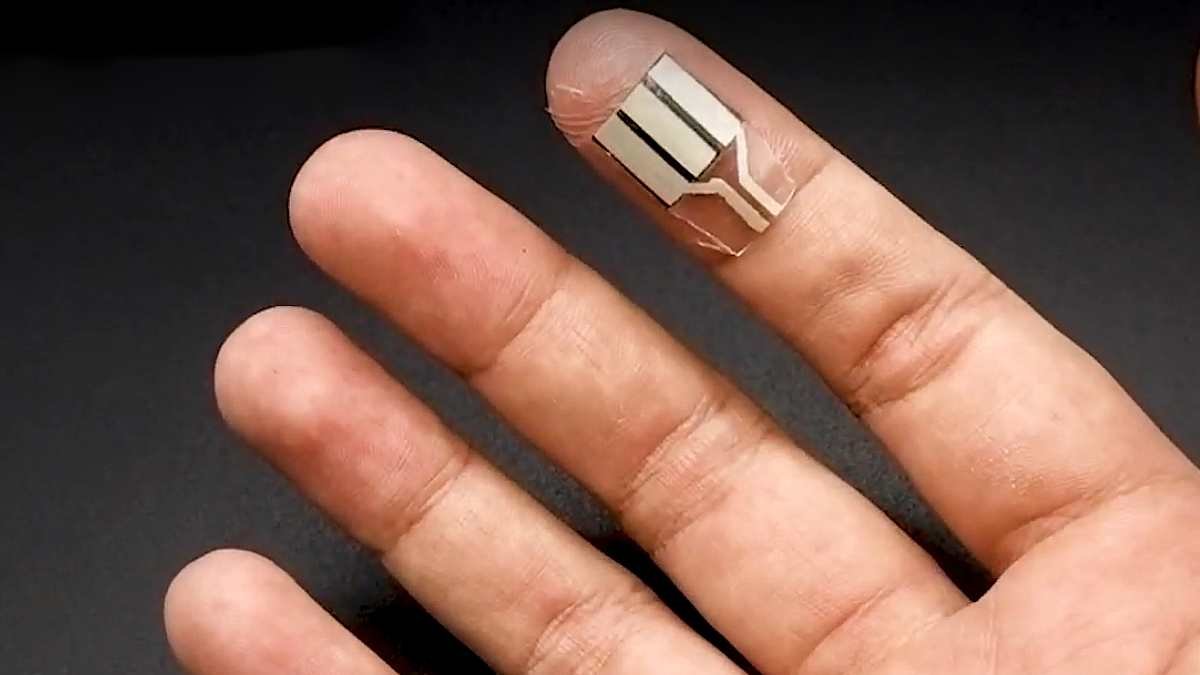A new wearable device allows energy harvesting from humans.
It turns the touch of a finger, or even micro-droplets of sweat, into a source of energy harvesting for small devices and sensors, according to a new study published today in the journal Joule.
Engineers at the University of California San Diego developed these thin, flexible strip, which can be worn on a fingertip.
They generate small amounts of electricity when a person’s finger sweats, or when the wearer presses on it.
What’s special about this device is that it generates power even while the wearer is asleep or sitting still.
This is potentially a big deal for the field of wearables, because researchers have now figured out how to harness the energy that can be extracted from human sweat even when a person is not moving.
Energy harvesting from humans becoming more and more efficient
To date, the device is the most efficient “on-body” energy harvester ever invented.
For example, it can produce 300 millijoules (mJ) of energy per square centimeter — without any mechanical energy input — during a 10-hour sleep session.
And a single press of a finger generates an additional 30 mJ of energy.
The device is the first of its kind, and represents a significant step forward for self-sustainable wearable electronics, said co-author Lu Yin.
“Unlike other sweat-powered wearables, this one requires no exercise, no physical input from the wearer in order to be useful,” he said.
“This work is a step forward to making wearables more practical, convenient and accessible for the everyday person.”
Previous sweat-based energy devices required intense exercise, such as running or biking, before the user sweated enough to activate power generation.
But the large amount of energy consumed during exercise can easily cancel out the energy produced, often resulting in energy return on investment of less than 1%.
In contrast, this device falls into what the authors call the “holy grail” category of energy harvesters.
Instead of relying on external, irregular sources like sunlight or movement, all it needs is finger contact to collect more than 300 mJ of energy during sleep, which the authors say is enough to power some small wearable electronics.
Energy harvesting from mouse-clicking or piano playing
The device also generates extra power from light finger presses, meaning that activities such as typing, texting, playing the piano, or even tapping in Morse code can also become sources of energy.
“We envision that this can be used in any daily activity involving touch, things that a person would normally do anyway while at work, at home, while watching TV, or eating,” said co-author Joseph Wang.
“The goal is that this wearable will naturally work for you and you don’t even have to think about it.”
This wearable energy harvesting device, which can generate power from mouse-clicking or piano playing, gets even more power from sweat produced by the fingertips, which are 24-hour factories of perspiration.
It’s a little-known fact that the fingertips are one of the sweatiest spots on the body; each one is packed with over a thousand sweat glands.
But not just any sweat-fueled device can work on the fingertip.
Collecting sweat from such a small area and making it useful required some innovative materials engineering, explained Yin.
The researchers had to build different parts of the device to be super absorbent and efficient at converting the chemicals in human sweat into electrical energy.
This latest energy harvesting technology is especially unique in that it could serve as a power source anytime, anywhere.
It does not have the same limitations as, say, solar cells, which only work under sunlight, or thermoelectric generators, which only work when there’s a large temperature difference between the device and the surroundings.
So how much energy? One night’s sleep can power a smartwatch for 24 hours
The researchers had subjects wear the device on one fingertip while doing sedentary activities or sleeping.
From 10 hours of sleep, the device collected almost 400 millijoules of energy, enough to power an electronic wristwatch for 24 hours.
By way of comparison, one millijoule is equivalent to the amount of energy deposited by a one-cent Euro coin falling from a height of 5 centimeters.
From one hour of casual typing and clicking on a mouse, the device collected almost 30 millijoules.
And that’s just from one fingertip.
Strapping devices on the rest of the fingertips would generate 10 times more energy, the researchers said.
A much higher return than previous energy harvesting devices
“By using the sweat on the fingertip, which flows out naturally regardless of where you are or what you’re doing, this technology provides a net gain in energy with no effort from the user.
This is what we call a maximum energy return on investment,” said Wang.
“Compare this to a device that harvests energy as you exercise,” explained Yin.
“When you are running, you are investing hundreds of joules of energy only for the device to generate millijoules of energy.
In that case, your energy return on investment is very low.”
“But with this device, your return is very high,” he said.
“When you are sleeping, you are putting in no work.
Even with a single finger press, you are only investing about half a millijoule.”
How these energy harvesting strips work
The device the researchers developed in this study is a type of energy harvester called a biofuel cell (BFC), and is powered by lactate, a dissolved compound in sweat.
From the outside, it looks like a simple piece of foam connected to a circuit with electrodes, all of which is attached to the pad of a finger.
The foam is made out of carbon nanotube material, and the device also contains a hydrogel that helps maximize sweat absorption.
The device is a thin, flexible strip that can be wrapped around the fingertip like a Band-Aid.
A padding of carbon foam electrodes absorbs sweat and converts it into electrical energy.
“The size of the device is about 1 centimeter squared.
Its material is flexible as well, so you don’t need to worry about it being too rigid or feeling weird.
You can comfortably wear it for an extended period of time,” says Yin.
The electrodes are equipped with enzymes that trigger chemical reactions between lactate and oxygen molecules in sweat to generate electricity.
Underneath the electrodes is a chip made of what’s called a piezoelectric material, which generates additional electrical energy when pressed.
As the wearer sweats or presses on the strip, the electrical energy gets stored in a small capacitor and is discharged to other devices when needed.
“Not just another cool thing that can generate a small amount of energy”
“Our goal is to make this a practical device,” said Yin.
“We want to show that this is not just another cool thing that can generate a small amount of energy and then that’s it–we can actually use the energy to power useful electronics such as sensors and displays.”
The researchers were able to use the device to power effective vitamin C- and sodium-sensing systems, and they are optimistic about improving the device to have even greater abilities in the future, which might make it suitable for health and wellness applications such as glucose meters for people with diabetes.
“We want to make this device more tightly integrated in wearable forms, like gloves.
We’re also exploring the possibility of enabling wireless connection to mobile devices for extended continuous sensing,” Yin says.
To that end, the team is making further improvements to the device so that it is more efficient and durable.
Future studies will include combining it with other types of energy harvesters to create a new generation of self-powered wearable systems.
Below, you can watch a video of this new energy-harvesting device in action.
Study: “A Passive Perspiration Biofuel Cell: High Energy Return on Investment”
Authors: Muyang Lin, Mengzhu Cao, Alexander Trifonov, Fangyu Zhang, Zhiyuan Lou, Jae-Min Jeong, Sang-Jin Lee, and Sheng Xu
Published in: Joule
Publication date: July 13, 2021
DOI: https://doi.org/10.1016/j.joule.2021.06.004
Related: Using an air-based hand dryer spreads ten times more germs than using paper towels.




